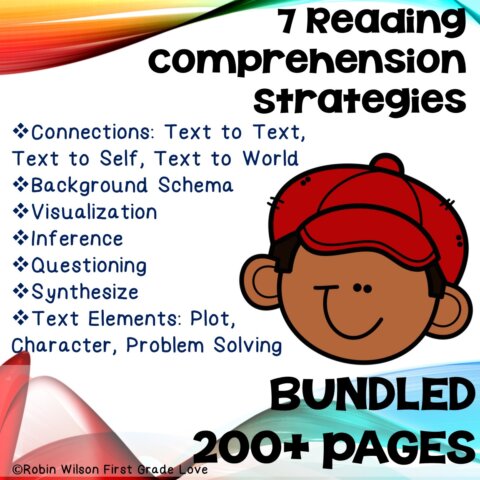The Dilemma with Reading Comprehension

I was recently tagged in a post of a mom calling out for help. Her child’s first grade teacher told her that her daughter could read words but couldn’t comprehend when reading the stories. Help! I will help you teach 7 Reading Comprehension Strategies!
This is an all too often issue with children, and I see this in my classroom year after year. We have to teach reading comprehension. For some students it doesn’t come as easy as others.
I also had a student that had the ability to read ANYTHING. She seriously could read words that were on the 5-6th grade word list, but simple comprehension questions would get a blank stare. She understood the process of stringing letters together to make words, but her brain didn’t make the connection that these words were telling a story.
On the other end of the spectrum, I have had students that had difficulty reading words, but could comprehend books that I read aloud far beyond the first grade level. Sometimes their ideas and connections were so deep they surprised me with things I had not thought through. The bottom line is that some students read words first, and some students process the reading comprehension first. The challenge is to get to the place students can do both! I also recommend this book, 7 Keys to Comprehension, by Susan Zimmerman and Chryse Hutchins.
What is Reading Comprehension?
Reading comprehension is the ability to read the words phonetically, while processing the information into meaning. It combines two processes. The first is putting together a string of symbols (letters and their sounds), and the second is making meaning of the sentences. It is a quite complex process that we as adults don’t think about when reading.
Beginning readers sometimes struggle with comprehension. However, you can teach comprehension to children even if they don’t read, but by reading TO them.
There are several strategies that help young readers begin to comprehend or understand the stories they are reading. The first thing is just make them aware that these words they are reading are actually telling them a story. If they don’t understand that, then continue to work on reading words and tell them again. Eventually, they will ‘see’ the story and begin to comment their own thoughts. Until then, continue to work on the actual reading, while also teaching strategies to make them think about the story.
There are 6 reading comprehension strategies or ‘skills’ that you can use to teach comprehension that I will be sharing in this article. You do not need to purchase the books that I am referring to in the following examples. You can get the general idea and use the books you already have.
The Process of Teaching the Strategies
I usually spend an entire week on each strategy, sometimes 2-3 weeks. Can I tell you a secret? I don’t always get to ALL the strategies in a year. But sometimes I do! Sometimes, I get through them early in the year. It really depends on the pace of my class. Some groups understand things quicker and some groups tend to need a bit more time. When teaching young children, it is better to understand a few of these rather than push through all of them, so take your time and enjoy the books that you are reading. Start with the first strategy and then linger there a while, enjoying the process.
I have linked a few books to help you understand how to teach. These are not affiliate links. I do not get commission if you buy them. I needed to be able to give you ideas of ways you can teach these using read alouds. You can also:
- Watch Youtube.com read aloud books, then discuss. Just type in the name of the book in front of “read aloud.”
- Use books that you already own after you get the general idea of how to teach these.
1. Reading Comprehension Strategy: Connections- Text to Text, Text to Self, Text to World

a. Text to text: Connecting two texts together. For example, you can read a book about the “Old Lady that Swallowed a…” and read another one in that series and talk or write about how they are similar. They both ate things, the kinds of things they ate, the fact she was able to digest them both, and that at the end, she made things from her spew. Ugh! But the kids LOVE IT!!
b. Text to Self: Connecting the book to something they love doing or have done before. For example, if you read a book about a rock such as in “Ricky, the Rock that Couldn’t Roll,” then you can reminisce about the times they found a rock, or if they have a rock collection. This could also be anything that happened from the book. In the plot, friends helped Ricky roll down the hill. Has your child or student rolled down a hill or did friends help them do something similar?
c. Text to World: This reading connection is about connecting to the world. I don’t think it necessarily has to be about the physical Earth, but anything that happened or that is out in our world. Think about movies, holidays in our country or in other countries. This allows you to expand on events as well, maybe a festival, or school event coming up. If you read, “Steve the Dung Beetle,” you might be able to do a guided research on Dung Beetles.
2. Reading Comprehension Strategy: Background Knowledge or Schema
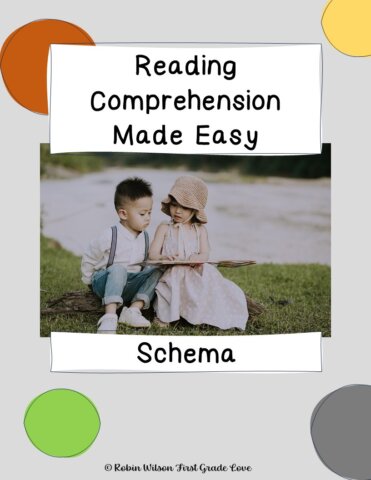
Schema is a fancy way of teaching background knowledge, or what students may already know about something they are reading. If a student doesn’t have schema about something they are reading, then comprehension is lost. For example, if your child is reading about a jet ski, but have never seen one, or even heard the term, they would have trouble comprehending what that is. At that point, it is important to educate them on the subject. You might look up pictures or YouTube videos with jet skis.
If you are reading a book called “Tattle Tongue,” and your child or student has never heard that phrase, it is important to share examples of what tattling is to your student/s to give them Schema, (Background knowledge.) I like to share both terms because these are used interchangeably in teaching reading comprehension.
3. Reading Comprehension Strategy: Visualizing
The comprehension strategy of visualizing is simply being able to picture the story in your head. I have heard some teachers say this as “see the movie in your head.” This strategy lets you visualize what you are reading. This will prepare students to be able to read higher level chapter books later that do not have pictures. In most primary books, pictures are used to support the readers’ comprehension, but as you know books get more complicated, and the pictures go away. So this is an important reading skill to develop early.
One way you can teach visualizing is to read a page without letting students see the picture and ask them to draw what the ‘see.’ Have patience because they may not be able to do this one just yet. Maybe you can draw together, or show a model on the overhead or smart board. If you teach at home, simply talk about what you read and help the child draw this. You can also use books that are simple, but have no pictures on a few pages. Create the pictures that aren’t there to add to the story. Junie B. Jones or Magic Tree House has pages without pictures. (My students beg to see the pictures and are surprised when I tell them, “There are none. Let’s make one!” They don’t even realize they are learning the reading strategy of visualizing.
4. Reading Comprehension Strategy: Questioning
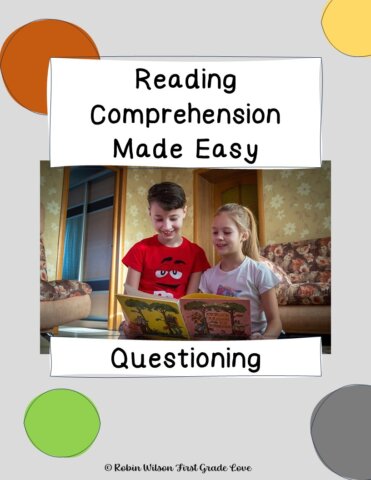
Questioning is exactly how it sounds. You ask, they ask, we ask together. Who, what, when, why, where, and how are great places to start. If your students ask a question about the book, stop and guide them with this strategy if you haven’t taught it specifically. Let them know they are doing amazing by asking questions and this strategy will help them become a great reader.
A way you can teach this strategy is by teaching them to ask the “W” questions when reading. Who is this book about, what are they doing, when is this taking place, why would they do this or why is the author writing this book, where are they (setting), and how are they doing these things? Depending on the topic, not all of the question strategies will fit, but it really is a great place to start. I teach my students to hold up their hand and point to each finger repeating Who, what, when, why, where and how. The ‘how’ is when I touch my palm. If they can answer 2-3 of these questions from the book, they have a great beginning for reading comprehension. A great way to practice this is with the book, “Brittanica’s First Big Book of Why.”
5. Reading Comprehension Strategy: Inference
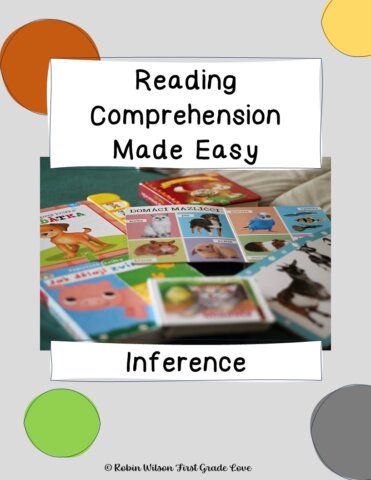
Inferencing can seem complicated, but broken down on a primary level, it is not as difficult as it seems. We inference when we make conclusions from a story that is not actually written.
Identifying feelings of a main character when it isn’t written in the text is a wonderful place to start with primary students. When reading, “Two Bad Ants,” you can ask a young reader how do the ants feel while reading this story. They are making an inference, especially if it is not written. When we were little, my teacher taught me this as “reading between the lines.” Haha!
6. Reading Comprehension Strategy: Synthesizing
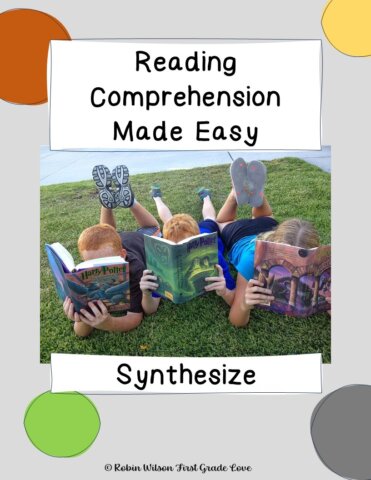
When you synthesize you change your mind. This happens when you are expecting a book to end in a way, and then when it goes a different way, you have to change your thinking processes. As adults, this happens when we are reading mysteries and are trying to figure out “who dunit?” We might begin to think one way, but then we synthesize by changing our mind. Sometimes an author can lead you several different directions before you come to the conclusion.
When teaching this reading comprehension strategy to young children, you can use picture books. When I read aloud, I might ask students how they think this book will end or what the character may do next. I don’t tell them the answer, but just allow them to think their idea may be right. When they come to the conclusion of a different direction the book is going, they synthesize, and I tell them, “What a great reader with amazing comprehension. You are synthesizing!”
A good book to teach synthesizing is, “The Giving Tree.” I know the first time I read this, I thought surely the man wouldn’t take every bit of the tree. Before reading, ask students how they think this tree and the man will end up together in the end. Let them make assumptions just by chatting. If you want to work on sentence writing, have them write out their ideas.
A word of caution. Allow the students to see you were wrong in your first thoughts or ideas. Sometimes students can be triggered or upset if they find out they were wrong. “Emphasize that good readers Synthesize.” Haha… see what I did there?
7. Main Idea or Moral, Plot, Characters, Problem and Solution
It is important to teach the plot of any story. This will come up again and again in comprehension questions, testing, and more.
Plot: Students should be able to state the beginning, middle, and end of a piece.
Characters: Can students name all or most of the predominate characters in a story?
Main Character: Can student identify the main character?
Problem and Solution: Can student identify the problem in the story?
Main Idea or Moral of the story: Can students tell you what the main idea or moral of the story is?
These are basic questions that you will see over again in many testing platforms. They are also fun to identify. You will not want to do all these at once, but focus on one at a time.
Summary

This article is the big picture for teaching reading comprehension to primary students.
I will be breaking down each strategy in individual posts. Here is the first one. Are You Teaching Text to Text Reading Comprehension skills?
All of the activities above can be done with a bit of DIY! However, if you would like to have ready to go worksheets and printables, click here! This is ALL Reading Comprehension Strategies I have discussed in this post. You do not need to purchase to do all the activities above.
To Read More About the 7 Comprehension Strategies
- Making Reading Comprehension Strategies Simple with 7 Strategies
- Text to Text Connections
- Text to Self Connections
- Text to World Connections
- Visualization Reading Comprehension Strategies
- Background Knowledge Reading Comprehension
